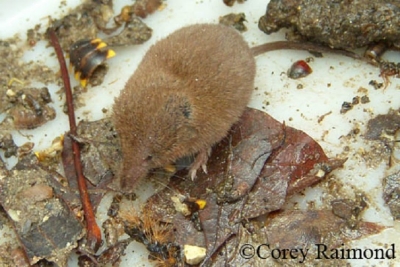Southeastern-shrew, Sorex longirostris
The Southeastern Shrew is an underground burrower and occurs across the state.
Description: A tiny mammal with reddish-brown fur and a buff colored belly. They have a very pointed snout; a cylindrical body; tiny, black eyes; and short, slender legs. The tail is long (more than one-half the length of head and body).
Length: 3.0 - 4.3 inches
Tail: 1.0 - 1.6 inches
Weight: 0.10 ounces
Similar Species:
•North American Least Shrew, Northern Short-tailed Shrew, and Southern Short-tailed Shrew have shorter tails.
•Cinereus Shrew has a more grayish brown coloration and a slightly shorter tail with an obvious constriction at the base.
•American Pygmy Shrew is smaller and the larger Smoky Shrew is darker.
•Long-tailed Shrew and American Water Shrew have longer tails.
Habitat: Occurs in a variety of habitats, but often found in bogs, marshes, or swampy areas, or in dense ground cover (briers or honeysuckle vines) in wooded areas.
Diet: Mostly spiders, butterfly and moth larvae, slugs and snails, centipedes, and some vegetable matter.
Breeding information: The breeding season begins in March and the first litter is born in April, sometimes followed by a second litter in the summer. Females build nests made of leaf litter under decaying logs or inside the log. Litters range from 1-6 young.
Status in Tennessee: Southeastern Shrews are Deemed in Need of Management by both TWRA and Tennessee Department or Environment and Conservation. They are uncommon, but their distribution is widespread.
Fun Facts: •The Southeastern Shrew was formerly called "Bachman's Shrew," which stems from the naturalist John Bachman (friend of John James Audubon) who discovered it in 1837.
Best places to see in Tennessee: Edges of swamps, rivers, or old fields during or shortly after a rain.
